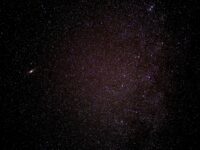On October 12, 2021, a team of Australian researchers, led by PhD student Ziteng Wang, reported the discovery of a possible new object in space. The mysterious source of energy has been labeled ASKAP J173608.2−321635. The catch? It doesn’t fit into a category of anything scientists have ever seen before.
ASKAP J173608.2−321635 was first noticed as a radio source. It is named after the Australian Square Kilometre Array Pathfinder, the telescope used to find it, as well as the coordinates where it is located. Scientists attempted to identify the type of source through the process of elimination by performing several tests using radio imaging, pulsar searching, X-rays, and near-infrared imaging. Originally, scientists wondered if it was some type of star, specifically a pulsar, which is a highly magnetized neutron star. However, after the tests were done, it became clear that the object did not align with any of their suspected classifications. Some types of stars have varied radio waves just like the mystery source did, but the X-ray and near-infrared tests failed to detect anything, making it very unlikely for the object to be a type of star. It didn’t match the criteria of a pulsar because pulsars are very regular in their production of energy, and the mysterious object had been very inconsistent, fading at some time points and completely vanishing from detection at others.
ASKAP J173608.2−321635 has been classified as highly-polarized and highly-variable. Let’s break down what these classifications mean. Most common light sources are unpolarized, meaning light emits in random, multiple directions. Think of a lightbulb lighting up a room; light shines all around it. Light can become polarized if it is filtered, reflected, or scattered properly. For example, polarized sunglasses filter by absorbing one direction of light, either vertical or horizontal. By blocking one direction, they reduce glare and let the other direction reach the eye. In ASKAP J173608.2−321635, the electric and magnetic forces coming off of it seem to be filtered into one direction. At this stage, it is unclear if the polarization filter is due to magnetic fields and debris between Earth and the source or if the actual source is highly magnetized and doing it on its own.
“The X-ray and near-infrared tests failed to detect anything, making it very unlikely for the object to be a type of star”
The unknown object is also highly variable in its emission of energy. It was tracked for several months, and astronomers were baffled by the way the object sent out constant bursts of energy only to disappear after a few weeks. The brightness varies by a factor of about 100, flickering on and off in random patterns. Wang noted in an interview with the University of Sydney that the team had never seen variability on a scale quite like this before, leaving them with many questions.
Although still somewhat confused, researchers have identified other instances of space activity that have similarities to ASKAP J173608.2−321635. The new source shares similarities with a phenomenon known as galactic center radio transients, also known as GCRTs. There have been three GCRTs identified in the 2000s, and there are others currently under suspicion and review. Much about GCRTs is still unknown, but they do have several features attributed to them, some of which correspond to ASKAP J173608.2−321635. However, the main timescale of energy emissions for the new object does not match the other identified GCRTs, so that must be kept in mind. But as of now, GCRTs are the closest identified relative of ASKAP J173608.2−321635.
Although in its early stages of research, scientists are inching toward the conclusion that ASKAP J173608.2-321635 may be the first discovery of a new type of cosmic object. In what is an eerily exciting development, this discovery is another reminder of just how extraordinarily little is known about the universe around us.
The Astrophysical Journal (2021). DOI: 10.3847/1538-4357/ac2360
Nature (2021). DOI: 10.1038/d41586-021-02836-5






